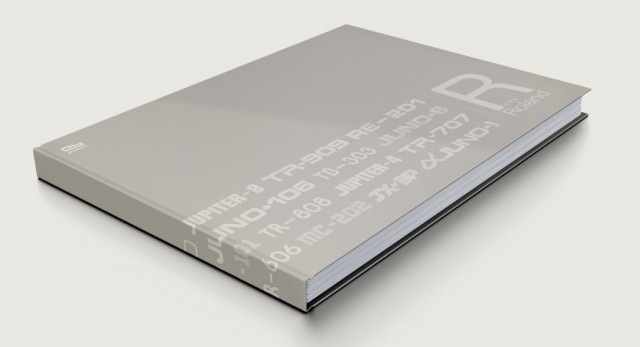
R Is For Roland is a new hardcover book about the history of 23 selected Roland synthesizers and drum machines, from 1973 until 1987, that revolutionized the world of electronic music.
The book features over 384 pages, filled with portraits of the machines, detailed insight into the history and scores of artist interviews.
It features Lee “Scratch” Perry, Au Revoir Simone, Portishead, Nightmares On Wax, The Hacker, Jeff Mills, The Egyptian Lover, Plastikman, Mathew Jonson, Legowelt, Martyn Ware and many more…
Here is a video preview, via Electronic Beats TV:
Michal Matlak (aka Analog Roland Orchestra) served as the book’s central author and, alongside illustrator and photographer Tabita Hub, he created a book dedicated to some of the classic Roland instruments that have played an integral role in shaping electronic music.
R Is For Roland will be released on May 11th 2015.

There better be a chapter dedicated to the D-Beam or Roland can go suck a pickle for all I care.
That’s the funniest thing I’ve read all day!
something and beer?
one day we’ll get the long-coveted D-bag midi tool, for further revolutionary possibilities.
46,64 €
plus Shipping
Where’s S Is For Steiner-Parker?
It’s all well, but seems like a missed opportunity if there are no interviews with designers of the machines. You can already read numerous interviews with the artists, but when it comes to the creators of gear, Roland is almost completely undocumented.
That is because apparently it is Roland’s policy to not put emphasis on single engineers or developers but always on the team.
There is a very interesting portrait of the company and an interview with two of its engineers on the German website AMAZONA.
http://www.amazona.de/report-roland-japan-werksbesichtigung/
http://www.amazona.de/interview-roland-japan-hidemasa-togai-und-toshio-yamabata/
Unfortunately, both articles are German only, but Google translate may help.
This looks super cool and I really want it, but it would be $64 USD with shipping, plus the foreign currency fee from my credit card company which seems to be running a few dollars.
Printed in Berlin and I can see the ligatures are in folios and are sewn in a cloth binding so it is definitely commensurate with manufacturing cost.
I will talk to my partner as to whether we can indulge. Perhaps for some upcoming holiday? I see that May 11 the release date is Nisga’a Day.
I was hoping it was an ABC book that I could get for my daughter when I read the title….
Had to order it. I hope with the growing popularity of synthesizers we will see more books and media like this
I was hoping for a pop-up book… oh well…
I doubt if they will devote a chapter to Roland’s failures but there were some. The “Roland Studio Package” comes to mind which combined a PC V-Link interface (RPC-1), Roland digital mixer (VM-3100Pro) and a stripped version of Logic – it never worked right and support was awful.
“Tabita Hub [s]he created” its a woman!
It’s referring to the author, Michal Matlak.
Comma added to help clarify this.
Given that it was unequivocably Tabita Hub’s project, perhaps rather than add a comma, a modest change to word order would be reasonable?
Such as:
> Tabita Hub served as the book’s central creator and was responsible for concept, design, illustrations, and product photographs. She collaborated with Michal Matlak who supplied the text. Tabita’s book covers many of the most prominent Roland instruments which played an integral role in shaping electronic music history.
The current phrasing cites Matlak as the primary creator of the project, which, despite his significant and important contribution, is of course incorrect and misleading.
No slight intended to Hub – the credit info in the article comes directly from the publisher, Electronic Beats.
Here’s how the credits are listed on the book’s site:
An illustrated book by Tabita Hub
Written by Michal Matlak and Florian Anwander
Yes, I see that now. Although still, the order is rather important in that listing.
In the video, it is made clear and simple that this is Tabita’s project. She originated, developed, and defined its scope. She was the primary agent. At one point, she did bring some very talented friends in as consultants. However, it is clearly not a project they originated, but it is still hers even though one of them is more “famous” and more “male” than she is. Would you not agree with this?
Reversing the order of contributions changes what factually and historically happened, changes who did which things. I do see that that impression is due to prioritization of certain words over other ones which gives a different impression of who is behind this high quality craftsmen quality project.
Beautiful work.
I agree it would have been cool to hear from some of the creators.
No DDR-30?
Awesome. Including the hard working and motivated Germans behind the book.
wonder if there will a an electric one, like the yamaha synth book
Is this analogue only, or do they also have an digital copy? And maybe think of selling the pages separately so people can then only buy the pages they need, and they can stitch the pages together themselves into an incoherent mess, which is a more module approach. But good stuff all the same as for many years it was, Aaargh is for Roland.
Do they have a chapter on Roland wedding band gear?
O is for Overpriced.
L is for lame?
n is for not good?
d is for dumb?